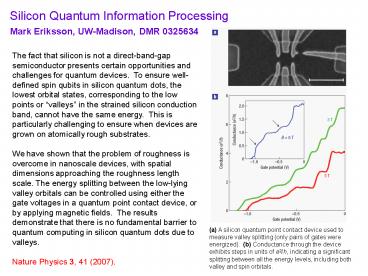Silicon Quantum Information Processing
1 / 2
Title:
Silicon Quantum Information Processing
Description:
... demonstrate that there is no fundamental barrier to quantum computing in silicon ... Our grant helps support the Physics Learning Center at the University of ... –
Number of Views:20
Avg rating:3.0/5.0
Title: Silicon Quantum Information Processing
1
Silicon Quantum Information Processing Mark
Eriksson, UW-Madison, DMR 0325634
The fact that silicon is not a direct-band-gap
semiconductor presents certain opportunities and
challenges for quantum devices. To ensure
well-defined spin qubits in silicon quantum dots,
the lowest orbital states, corresponding to the
low points or valleys in the strained silicon
conduction band, cannot have the same energy.
This is particularly challenging to ensure when
devices are grown on atomically rough substrates.
We have shown that the problem of roughness is
overcome in nanoscale devices, with spatial
dimensions approaching the roughness length
scale. The energy splitting between the low-lying
valley orbitals can be controlled using either
the gate voltages in a quantum point contact
device, or by applying magnetic fields. The
results demonstrate that there is no fundamental
barrier to quantum computing in silicon quantum
dots due to valleys. Nature Physics 3, 41 (2007).
(a) A silicon quantum point contact device used
to measure valley splitting (only pairs of gates
were energized). (b) Conductance through the
device exhibits steps in units of e2/h,
indicating a significant splitting between all
the energy levels, including both valley and spin
orbitals.
2
Silicon Quantum Information Processing Mark
Eriksson, UW-Madison, DMR 0325634
Outreach Our grant helps support the Physics
Learning Center at the University of
Wisconsin-Madison physics department, both
financially and through direct involvement of our
members. The learning center trains
undergraduates to run small study groups as
tutors/mentors for introductory physics students,
focusing particularly on at-risk students,
including low-income and minorities.
Contributions from our ITR grant have allowed the
Learning Center to extend efforts to
calculus-based physics classes. This year, two
of our previous students have become tutors,
providing role models for other students. The
Physics Learning Center works in partnership with
the NSF Louis Stokes Wisconsin Alliance for
Minority Participation (WiscAMP) in science,
technology, engineering and mathematics.
PI Mark Eriksson (left) leads an informal lunch
session of undergraduate peer mentor tutors, and
staff.
A Physics Learning Center staff member leads a
review session for calculus-based physics































